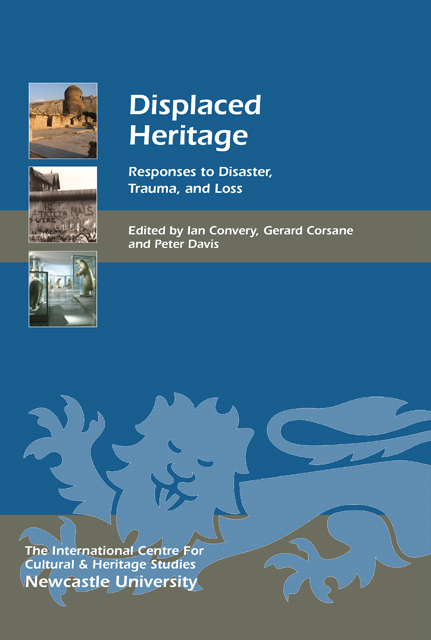Book contents
- Frontmatter
- Contents
- List of Illustrations
- Acknowledgments
- List of Abbreviations
- Preface
- Introduction
- Displaced Heritage: Histories and Tourism
- Displaced Heritage: Trauma, Confinement and Loss
- Displaced Heritage: Lived Realities, Local Experiences
- Displaced Natural Heritage
- Endpiece
- List of Contributors
- Index
- Heritage Matters
18 - Placing the Flood Recovery Process
Published online by Cambridge University Press: 24 February 2023
- Frontmatter
- Contents
- List of Illustrations
- Acknowledgments
- List of Abbreviations
- Preface
- Introduction
- Displaced Heritage: Histories and Tourism
- Displaced Heritage: Trauma, Confinement and Loss
- Displaced Heritage: Lived Realities, Local Experiences
- Displaced Natural Heritage
- Endpiece
- List of Contributors
- Index
- Heritage Matters
Summary
Contrarily, and without apparent irony, the preferred story in a natural disaster is one of good news: miraculous rescues and escapes; acts of heroism and bravery; selfless rescue workers from Rotherham; sniffer dogs from Barking; saintly surgeons from Surbiton. As the hope of more wide-eyed victims being plucked from the grave diminishes, as the disaster medics wrap up their kit and go, so too do the 24-hour rolling news teams. This is very expensive stuff, and nobody has the budget or the audience for the grim, dull depression of resurrection. (Gill 2010)
The writer A A Gill’s heartbreaking portrait of the aftermath of the Haitian earthquake of January 2010, in which up to 230,000 people died and more than 1 million were made homeless, raises the question of what it means to recover from a disaster. In the immediate aftermath of an event like Haiti, there is inevitably a focus on physical action and progress – the rubble is moved, survivors treated, fed and clothed – all of which corresponds to what emergency planners term the ‘response’ phase of the emergency. And yet what Gill is hinting at, beautifully captured in the notion of resurrection, amounts to something else entirely: the idea of recovery as a spiritual, physical and emotional process that is deeply hard to achieve and much less visible than the usual metrics applied to such situations would suggest (How many people are back in their homes? How many businesses are open for trading? What aspects of key infrastructure have been reopened?).
This chapter argues that, if we want to understand the recovery process then it is essential to think about just exactly what it is that is being recovered. Our case study is a qualitative, longitudinal study of people’s recovery from the floods of June 2007 in Kingston-upon-Hull, UK, in which over 8600 households were affected and one man died (Coulthard et al 2007). The aim of the research was to discover what the long-term disaster recovery process was like for people as they struggled to get their lives and homes back on track. The project, which is described extensively elsewhere (Whittle et al 2010), used in-depth qualitative methods that had been previously used to investigate people’s recovery from the 2001 Foot and Mouth Disease (FMD) disaster in Cumbria (Mort et al 2004).
- Type
- Chapter
- Information
- Displaced HeritageResponses to Disaster, Trauma, and Loss, pp. 199 - 206Publisher: Boydell & BrewerPrint publication year: 2014



